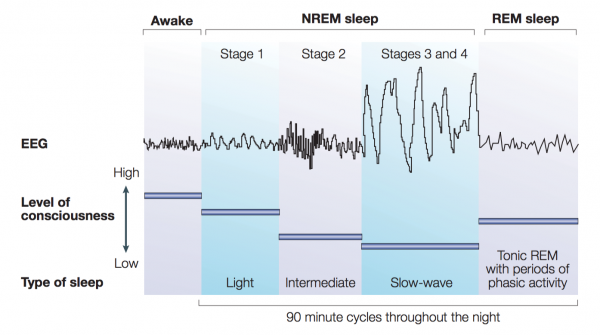- Last edited on April 30, 2020
Introduction to Sleep Medicine
Primer
Sleep is a naturally recurring state of mind and body, characterized by altered consciousness, relatively inhibited sensory activity, inhibition of nearly all voluntary muscles, and reduced interactions with surroundings. Adequate sleep is vital for good mental health. Evidence is mounting that poor sleep or insomnia can contribute to worsen of psychotic symptoms, including hallucinations.[1]
Sleep Disorders
Sleep-wake disorders encompass 10 disorders or disorder groups. Individuals with these disorders typically present with sleep-wake complaints of dissatisfaction regarding the quality, timing, and amount of sleep. Resulting daytime distress and impairment are core features shared by all of these sleep-wake disorders.
Basics
 Fig. ##
Sleep consists of two physiological states: non-rapid eye movement sleep (known as NREM) and rapid eye movement sleep (also known as REM):
Fig. ##
Sleep consists of two physiological states: non-rapid eye movement sleep (known as NREM) and rapid eye movement sleep (also known as REM):
- NREM sleep can be broken down into three stages: N1, N2, and N3 (or four stages based on: Stages 1, 2, 3/4).
- REM sleep is a different state of sleep characterized by high levels of brain activity and physiological activity similar to an awake state. REM sleep usually develops about 90 minutes after sleep begins. REM sleep on a polysomnograph appears the same as the awake stage. Therefore, REM cannot be identified by EEG alone, you need an EMG (and see absence of muscle activity) to confirm the presence of REM.
Immune Response
Sleep is also posited to play a role in the immune system.[2]
Physiologically Drowsy States
Certain periods of the day also contribute to sleepiness and drowsiness. The afternoons (12pm to 1pm), and early evenings (4pm to 5pm) are physiologically drowsy states when people feel more sleepy. This is evidenced in certain cultures, like afternoon siestas in Spain.[3]
Wakefulness
The posterior hypothalamus plays an important role in the regulation of sleep-wakefulness. Histaminergic neurons have high levels of activity during wakefulness and vigilance, and have significantly decreased activity during NREM and REM sleep.
Prevalence
- Insomnia (10-30%)
- Restless leg syndrome (2-15%)
- Parasomnias (5-10%)
- Obstructive sleep apnea (4-8%)
Sleep Stages
Sleep Stages
| Stage of Sleep | Description | EEG | Eye Movements | Muscle Tone |
|---|---|---|---|---|
| Awake | Wakeful state | Alpha waves (high frequency, 8 to 12 Hz) | Eyes move and blink | High voluntary tonic activity |
| Stage N1 (Stage 1) | Transition from wakefulness to sleep. Marker for very light quality sleep or sleep disruption. Occupies 5% of sleep cycle. Patients may often be in this stage, and think they are “not sleeping.” | Alpha waves (< 50% total), mixed with Theta waves (slow waves, 3-7 Hz) | Slow eye movements | Decreasing levels of high tonic activity |
| Stage N2 (Stage 2) | Occupies 50% of sleep cycle. Sleep spindles and K-complexes emerge during this stage. They are thought to be the brain's way of evaluating potential threats (i.e. external stimuli) while sleeping and to dampen arousals if the threats are not real. | Sigma waves (also known as sleep spindles, 11-16 Hz) with K-complexes (negative sharp wave followed by positive slow waves, 12-14 Hz) | None | Low tonic activity |
| Stage N3 (Stage 3 and 4) | Occupies 10-20% of the sleep cycle. This is homeostatic sleep (reduced BP, HR, cardiac output, RR), growth hormone is released. | Delta waves (low frequency, <2 Hz, with high voltage, >75 μV). | None | Low tonic activity |
| Rapid Eye Movement (REM) | Occupies 25% of sleep cycle. “Paradoxical state.” Resembles awake state, except there is muscle paralysis. Arousal and increased variability of autonomic state (BP, HR). Increased brain temperature, cerebral glucose metabolism and cerebral blood flow. | Irregular, low-voltage, fast waves, and mixed frequency activity, including: saw-tooth waves, theta activity, and slow alpha activity. | Rapid eye movement | Almost total muscle paralysis |
Scales
Measuring sleep quality can be done through scales, questionnaires, and sleep diaries:
Measurement Scales for Sleep Quality
| Name | Rater | Description | Download |
|---|---|---|---|
| Epworth Sleepiness Scale (ESS) | Patient | The ESS is a self-administered questionnaire with 8 questions. | ESS Information |
| Insomnia Severity Index (ISI) | Patient | The ISI has seven questions rated on a scale of 0 to 4.[4] | ISI Download |
| Pittsburgh Sleep Quality Index (PSQI) | Patient | The PSQI is an effective instrument used to measure the quality and patterns of sleep in adults. It differentiates “poor” from “good” sleep quality by measuring 7 components. | PSQI Download |
Sleep Disorders
Sleep-wake disorders encompass 10 disorders or disorder groups in the DSM-5, as listed below. Individuals with these disorders typically present with sleep-wake complaints of dissatisfaction regarding the quality, timing, and amount of sleep. Resulting daytime distress and impairment are core features shared by all of these sleep-wake disorders.
Sleep History
Sleep is Critical!
Understanding how to take a good sleep history, sleep disorders, and treatments is critical. Sleep disturbance is a common feature in many (if not all) psychiatric disorders. Differentiating between normal sleep disturbances, a sleep disorder, or a sleep disturbance due to a psychiatric disorder is critical to getting the patient the right treatment.- Sleep initiation insomnia? Ensure adequate sleep hygiene, rule out restless legs syndrome
- Sleep maintenance insomnia? Likely intrinsic sleep disorder, sleep study likely indicated
- Unusual or problematic behaviours in sleep? Sleep study likely required for accurate diagnosis
- Excessive daytime sleepiness? Ensure adequate sleep and eliminate underlying sleep disorders
Clinical Pearls
- When Stage 1 is high = patient is constantly having light sleep
- Waking up during the night is not uncommon or pathological; the time it takes to fall back asleep is what affects sleep quality